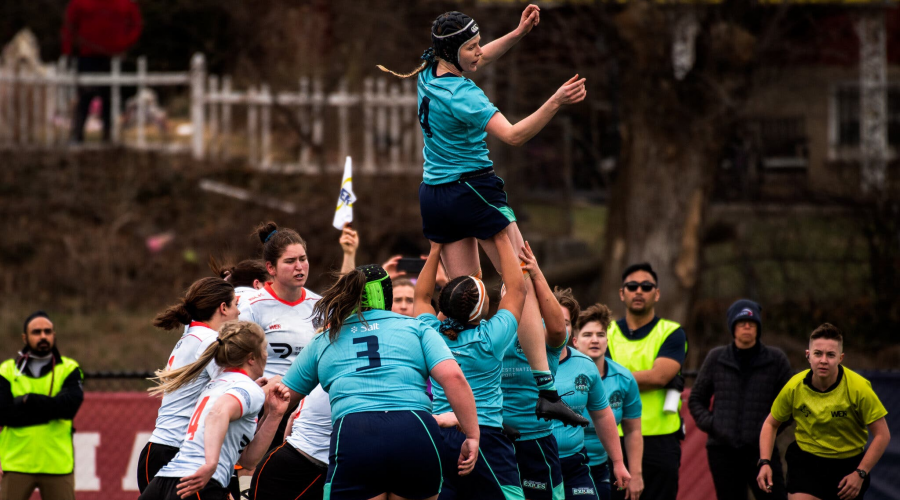The fans erupted as the home team, the Exiles, ran out of the tunnel and onto the turf at Memorial Field in Mount Vernon, N.Y., to play the Boston Banshees on March 22. Some waved signs and others swung scarves and towels as an age-old rivalry — Boston versus New York — was renewed in a contest between two new professional women’s rugby teams.
The crowd roared again when, after less than six minutes, the Exiles flanker Misha Green-Yotts pushed past a Banshees tackle and dove into the try zone. She had scored the first points of the game, the first for her team and the first of the inaugural season of Women’s Elite Rugby, the first professional women’s rugby league in the United States.
At the end of an aggressive and lively match, which the Banshees won, 29-27, in the final minute on a rare penalty try, fans supporting both sides stood and applauded as players basked in a moment that felt like a turning point in the evolution of women’s rugby in the United States.
“This has been a game that really was built on the backs of a lot of players ahead of us,” said Katie Lohaus, 27, who plays wing for the Banshees. “That brought both an excitement and then a pressure to perform, but not necessarily in a bad way. You just want to make the people that are supporting you, and have built it to this point, proud.”
For Nikki Richardson, 31, who plays fly half for the Exiles, hearing the fans was the “cherry on top” of the experience of playing in the league’s first match, and it took the edge off her team’s loss.


If that support can be sustained and built on, league officials say, it could create new opportunities for women’s rugby players and raise the level of play in the United States.
Women’s Elite Rugby, or W.E.R., was established on the foundation of the Women’s Premier League, a player-run, amateur organization that had served as the main pipeline to the women’s national rugby team since it was formed in 2009. After that league finished its 2022 season, its players, coaches and leaders began talking about ways to professionalize the game. In 2023, they established a board of directors and a full-time central office to create a structure for a new women’s league for 15-a-side rugby, known as 15s.
“We have an opportunity to improve how we play rugby in the U.S.” said Jessica Hammond-Graf, the president of W.E.R. and one of its founders. One of the long-term goals, she said, is to prepare players for the 2028 Summer Olympics in Los Angeles and the 2033 Women’s Rugby World Cup, which will be played in the United States.
The rosters of the W.E.R.’s six teams — based in New York, Boston, Chicago, Denver, San Francisco and Minneapolis-St. Paul — are filled with senior players and fresh talent: Some have played in Rugby World Cups and the Olympics; others are just getting their start at the professional level.
All players receive some compensation, though their pay rates have not been made public. Most players juggle full-time jobs with their training and game schedules to make ends meet.

By the time the World Cup kicks off in 2033, Hammond-Graf hopes to double the size of the league, bringing its six teams to 12.
W.E.R. kicked off at an auspicious moment — one that Hammond-Graf said few would have anticipated when planning for the new league began two years ago.
Global revenues in women’s professional sports are expected to exceed $2.3 billion for the first time this year, according to a report issued by Deloitte last week, driven primarily by the surging popularity of women’s basketball and soccer. Women’s professional hockey and volleyball are also attracting more fans, sponsors and investment.
If rugby hasn’t figured prominently in the buzz around women’s sports, there are signs that may be changing. The women’s team won bronze at the Olympic Games in Paris last summer, and breakout stars like Ilona Maher, a star of the U.S. women’s team who has 4.9 million followers on Instagram, have brought new audiences to the sport.
Even so, building an American audience for rugby could be a challenge, said Arianna Uhalde, associate professor of clinical marketing at the Marshall School of Business at the University of Southern California. U.S.A. Rugby, the national governing body, and Major League Rugby, the men’s professional league in the United States, have struggled even as the sport’s boosters have promised a rugby boom for years.
Still, rugby’s popularity abroad could create opportunities for the new women’s league, Uhalde said.

